
Former Brooklyn Center, Minn. police officer Kimberly Ann Potter appears in twin mugshots.
Opening statements in the trial of Kimberly Potter, the since-resigned Brooklyn Center, Minn. police officer who shot and killed Daunte Wright on April 11, 2021, commenced Wednesday morning with a scathing set of remarks by prosecutors as to the officer’s level of skill and attention. Potter, then 48, was on duty when she pulled her service weapon during a traffic stop and shot Wright, 20, ultimately killing him. Body camera footage of the Sunday afternoon shooting shows Potter yelling “Taser!” before ultimately firing her gun. After the gunshot rang out, Potter said, “Holy shit! I just shot him!”
Prosecutors painted Potter as an irresponsible officer who, despite years of training, made a fatal — and, as they allege, criminal — error.
The killing attracted considerable attention in the wake of the killing of George Floyd, Jr., by Minneapolis police officers just miles from where Wright died. Prosecutors — some of whom are the same ones who successfully tried Derek Chauvin — charged Potter with second-degree manslaughter. A subsequent count of first-degree manslaughter was eventually added to Potter’s docket.
“Police officers occupy unique positions of power and responsibility in our society,” prosecutor Erin Eldridge said while kicking off the state’s opening statement. “They hold positions of public trust, and they commit themselves to public service. They are accountable to the communities they serve, and Brooklyn Center police officers are no exception. Their fundamental duty is to protect the sanctity of life.”
“They promise to safeguard lives; they promise to serve and protect; to maintain calm; and develop self-restraint; and to be constantly mindful of the welfare of others,” Eldridge continued. “They promise never to employ unnecessary force or abuse.”
The state read for jurors the oath of a Brooklyn Center police officer and then pivoted to note that officers carry deadly weapons every day on the job.
“They’re trained to interact with people from all walks of life,” the prosecutor said, including people who “might not want to interact with them at all.” She said officers were expected to be “alert, attentive, and capable of performing their duties.”
Eldridge scolded Potter for pulling her Glock from her right hip, near her dominant hand, instead of her Taser from her left hip near her non-dominant hand.
“We trust them not to use those weapons rashly or recklessly, and we expect not to be shot dead on the street for no reason,” the prosecutor continued. “We expect them not to betray their badge, and we expect them to uphold their oath. We trust them to know wrong from right and left from right.”
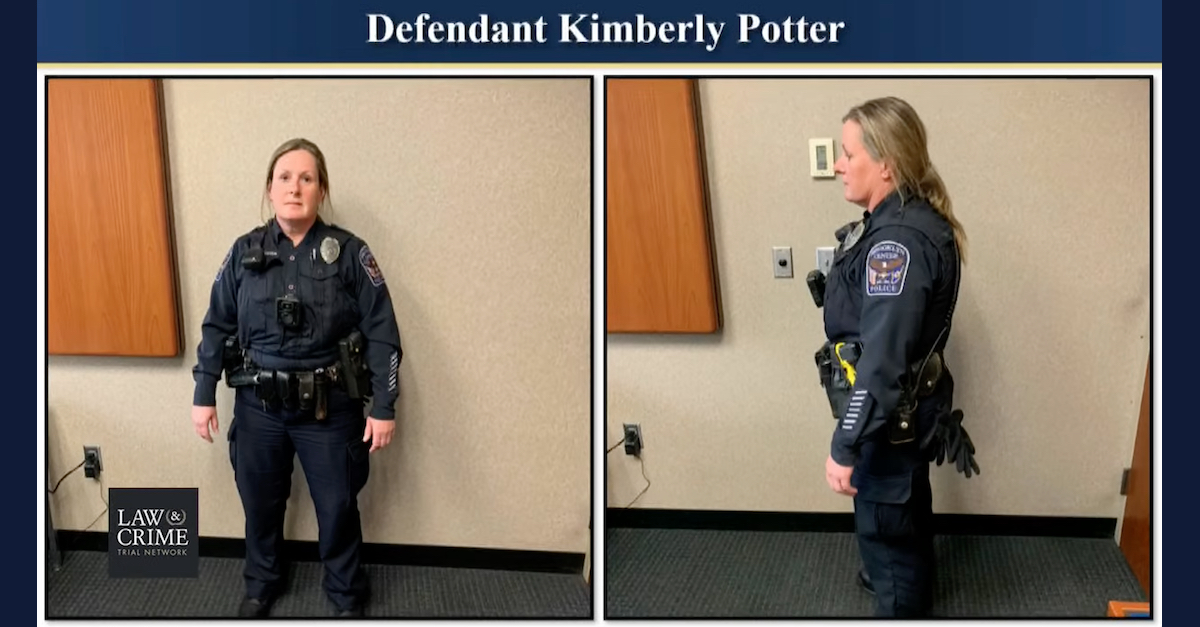
Two images show Kimberly Potter wearing her service belt. (Image via a slide used during prosecution opening statements.)
“This case is about an officer who knew not to get it dead wrong, but she failed to get it right,” Eldridge said. “This case is about the defendant, Kimberly Potter, betraying her badge, and betraying her oath, and betraying her position of public trust. And on April 11th of this year, she betrayed a 20-year-old kid. She pulled out her firearm, she pointed it at his chest, and she shot and killed Daunte Wright.”
The prosecutor said Potter was trained not to use her Taser on a fleeing suspect, how to recognize her gun from her Taser, and about the risks of pulling the wrong weapon.
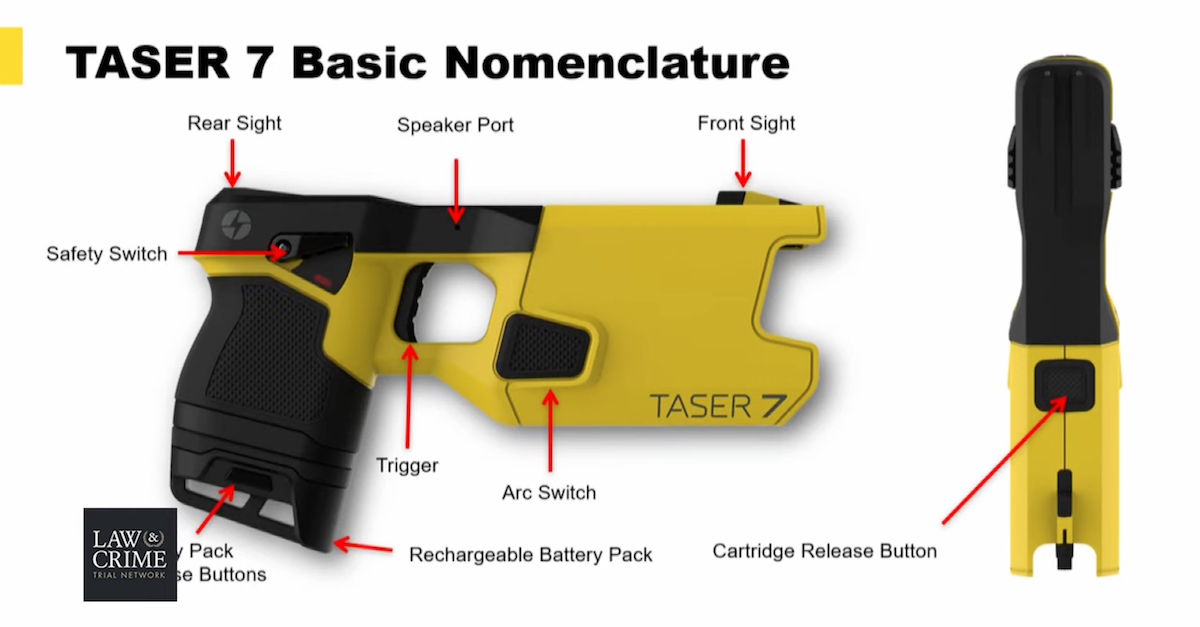
Prosecutors showed this diagram of a Taser 7, similar to that used by Kimberly Potter, during opening statements in the ex-police officer’s trial on Dec. 8, 2021, in Minnesota. (Image via a slide used during prosecution opening statements.)
Eldridge said Wright was on his way to take a new vehicle to a car wash the day he was shot and killed by Potter. Potter was training another officer — Officer Anthony Luckey — the day of the shooting. They pulled Wright over because he had an air freshener hanging from his mirror. The officers then noticed that Wright’s tags were expired; they eventually learned that his license was expired. Wright was forthcoming about his name and the names of his relatives, the prosecutor said. When they ran Wright through the computer, they realized Wright was the subject of an outstanding warrant. Another officer — Sgt. Johnson — arrived on the scene; the officers decided to arrest Wright on the warrant.
Officers asked Wright to get out of the car. He tired to flee when officers told him they were going to arrest him on the warrant.
“Daunte Wright was unarmed, he had no weapon, he was not violent, he did not threaten the officers in any way, he didn’t reach for anything,” Eldridge continued. “He got in the car, put his hands on the steering wheel, he didn’t come at the officers, didn’t throw any punches, didn’t kick anyone. He just pulled away, got back in the car while Officer Luckey was trying to maintain his grip on Daunte Wright’s clothing to pull him back out.”
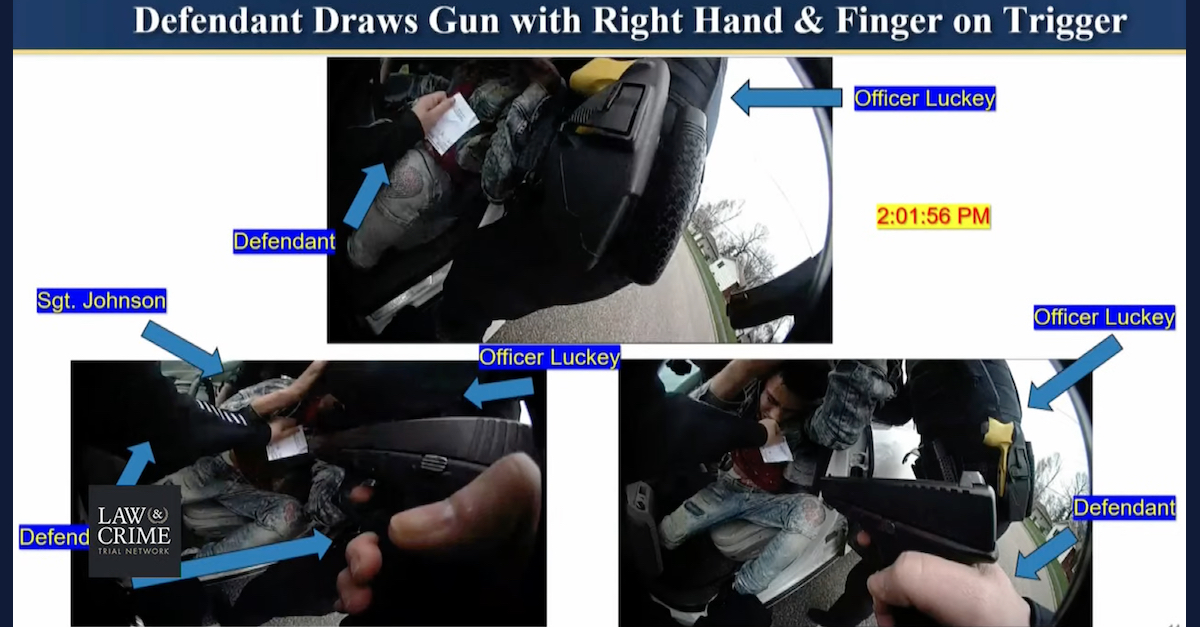
In a slide presented to the jury during opening statements, prosecutors pointed out the actions of defendant Kimberly Potter before she shot Daunte Wright. (Image via a slide used during prosecution opening statements.)
According to the state’s telling of the events, Potter “escalates the situation” immediately by acting “rashly and impetuously.” Potter drew her gun from the right side of her duty belt, with her finger on the trigger, according to Eldridge; Potter then yelled warnings about tasing Wright. She fired a few seconds later, the prosecutor said. The gunshot went off right under the face of Officer Luckey.
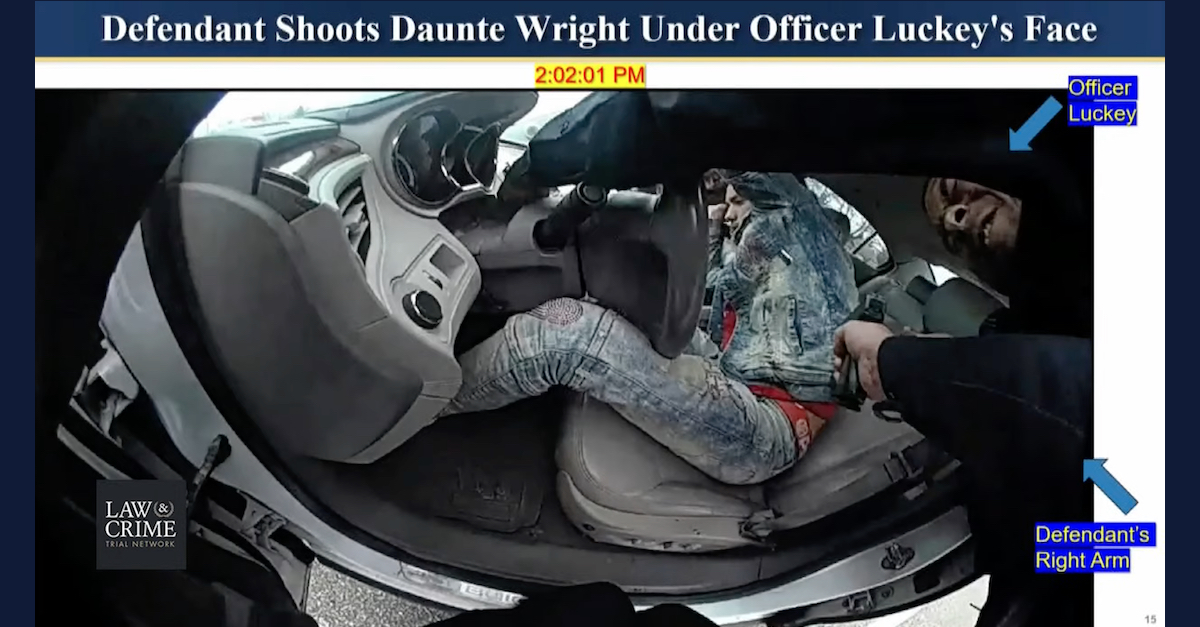
A still frame from Kimberly Potter’s body-worn camera shows the instant she shot Daunte Wright. (Image via a slide used during prosecution opening statements.)
Eldridge then played Potter’s body camera video in its entirety — replete with Potter’s screams and cries.
“I’ll tase you! I’ll tase you! Taser! Taser! Taser!” Potter yelled.
Then she pulled the trigger.
“Shit! I shot him!” she continued. “Yes! I grabbed the wrong fucking gun! I shot him! Oh my God! Oh my God!
Eldridge again cut into Potter.
“There is no do-over when you walk the streets with a loaded firearm,” the prosecutor told the jury. “When you’re entrusted with a deadly weapon as part of your job, there’s no do-over when you take a young man’s life. This is exactly what she had been trained for years to prevent, but on April 11th, she betrayed her badge, and she failed Daunte Wright.”

Split images show the final position of the vehicle driven by Daunte Wright and another vehicle Wright’s car struck before coming to rest. (Image via a slide used during prosecution opening statements.)
Eldridge then described how Wright’s vehicle traveled down the road and struck another car as he sat mortally wounded behind the wheel. She said Potter “did nothing” as other officers dragged Wright’s lifeless body from his car at gunpoint. Wright was pronounced dead on the scene, the prosecutor noted.
The gunshot wound “tore through his heart,” Eldridge said of Wright.
The state was careful to remind jurors that Potter did not intend to kill Wright. Instead, Potter shot Wright “without bothering to confirm what was in her hand” — first-degree manslaughter and second-degree manslaughter, the state suggested.
“These charges are in the realm of recklessness and culpable negligence,” Eldridge noted.
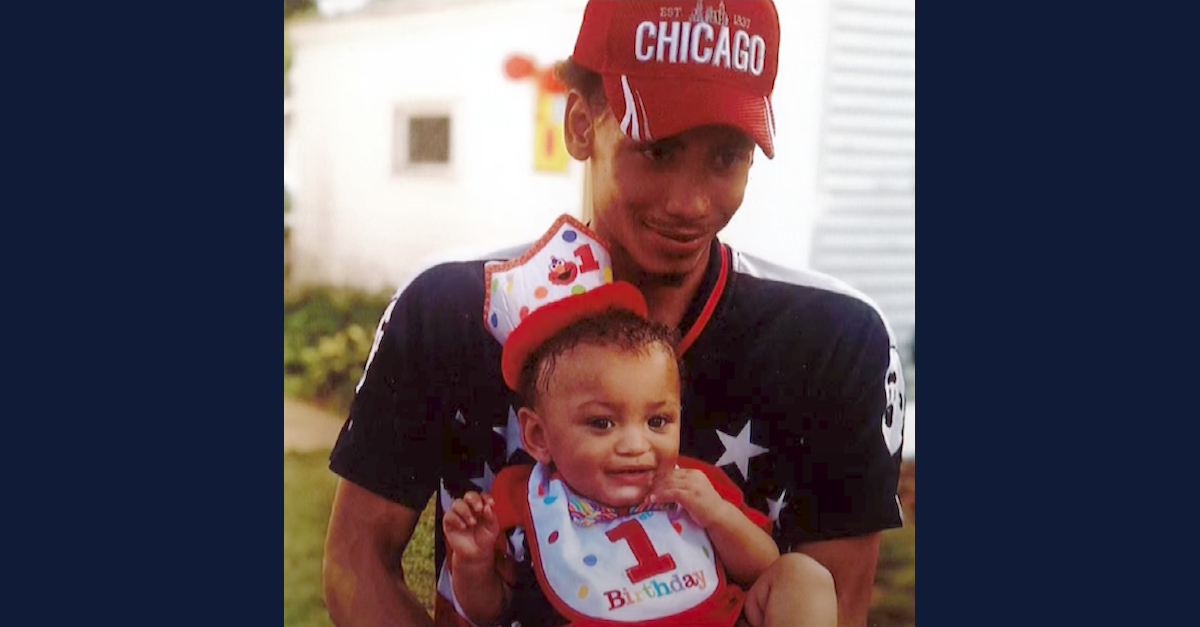
Prosecutors showed an image of police shooting victim Daute Wright during opening statements in the trial of ex-Brooklyn Center, Minn. Officer Kimberly Potter on Dec. 8, 2021. (Image via a slide used during prosecution opening statements.)
As the prosecutor continued, the judge warned Eldridge to “stick to the facts.” A few seconds later, the defense objected to the argumentative nature of the opening statement; the judge again warned Eldridge to give an overview of the facts — nothing more.
“The evidence will show that she flouted her training and flouted policy,” the prosecutor then said of Potter before launching into a lengthy discussion about the specifics thereof. The prosecutor, in summary, said that both the firearm an the taser were poor choices for attempting to bring Wright into custody.
While again referencing Potter’s allegedly mistaken use of the Glock, rather than the Taser, Eldridge noted that Potter’s Taser weighed 0.94 pounds and that her fully-loaded Glock weighed 2.11 pounds.

A slide presented by prosecutors during opening statements walked jurors through the differences between Kimberly Potter’s taser and her service firearm. (Image via a slide used during prosecution opening statements.)
Potter was trained over and over again through the years about how to position her weapons and how to cross-draw her Taser, Eldridge said. On March 2, 2021, Potter signed internal papers indicating that she had received warnings about how to properly use the Taser, the prosecutor noted while showing the jury images of Potter’s signature on department documents. Wright would be shot dead less than six weeks later.
“Confusing a handgun with a CEW [Taser] could result in death or serious injury,” those warnings said. “Learn the differences in the physical feel and holstering characteristics between your CEW and your handgun to help avoid confusion. Always follow your agency’s Guidance and training.”
The state wrapped up by against referencing Wright’s injuries. The judge called a 20-minute break before allowing the defense to present its opening statement — which Law&Crime will report in a separate piece.
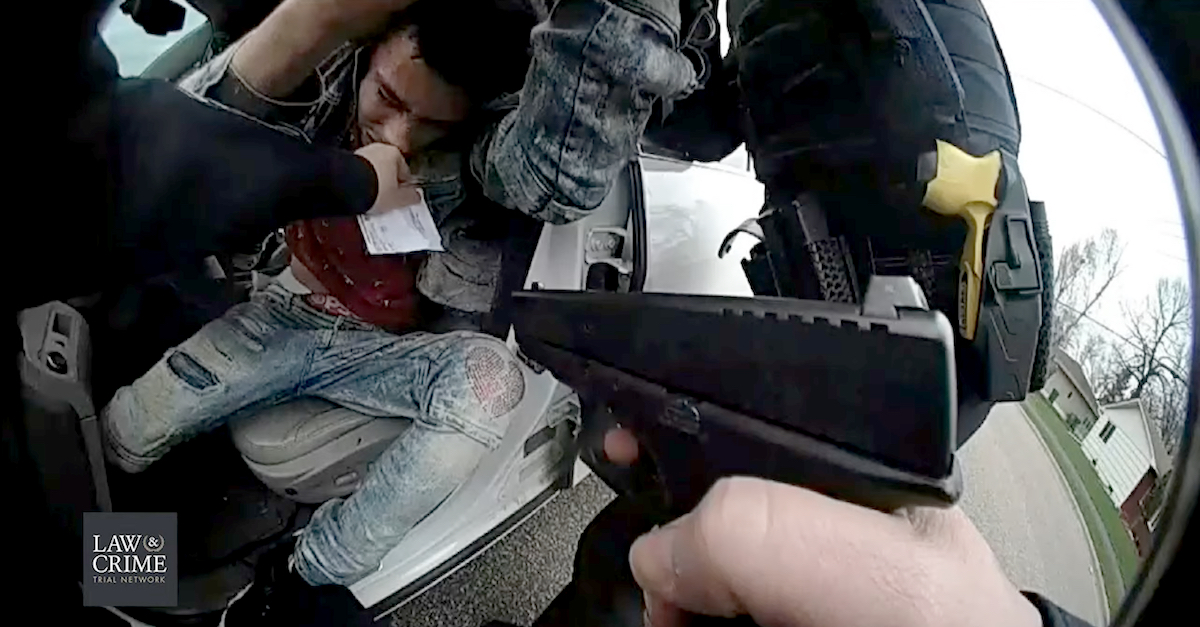
A still frame presented by prosecutors to a jury on Dec. 8, 2021, shows Kimberly Potter shooting and mortally wounding Daunte Wright. (Image via a slide used during prosecution opening statements.)
Prior to opening statements, the judge overseeing the case recapped several evidentiary rulings. The state wanted to admit five “spark of life” photographs; the judge ruled that the state could use only three of the proffered images. (The phrase “spark of life” was a reference to Minnesota case law that allows prosecutors to venture — to some degree — into the personal details of a victim’s life. Generally, such details are not directly relevant to the legal question of who killed the victim; nonetheless, the courts do allow prosecutors to go into some such details.)
The defense objected to autopsy photos which showed Wright’s eyes open. The state called the photographs “relevant and necessary” despite the defense saying it did not contest that Wright died of a gunshot wound. The judge overruled the objection.
Additionally, the judge refused to allow certain information about Wright into the then-imminent trial.
“Any type of evidence with respect to bad behavior on the part of Mr. Wright would not be admissible unless Officer Potter was aware of it at the time of the incident,” District Court Judge Regina M. Chu said. “The key issue in this case is Ms. Potter’s state of mind when this happened, and the Xanax has nothing to do with that issue and would only serve to mislead or confuse the jury.”
The judge also said she would allow photo and video evidence involving a passenger in Wright’s car.
Further, the judge summarily dismissed defense claims that the rules of evidence were preventing Potter from mounting a defense under the Sixth Amendment.
However, Chu elsewhere shot down prosecution attempts to muzzle some of the defense hypotheses.
“I’m not going to constrain the defense from making their arguments” about different theories of what the factual evidence shows, Chu said.
Specifically, the judge said officers could testify about their training involving Tasers.
[images as noted]